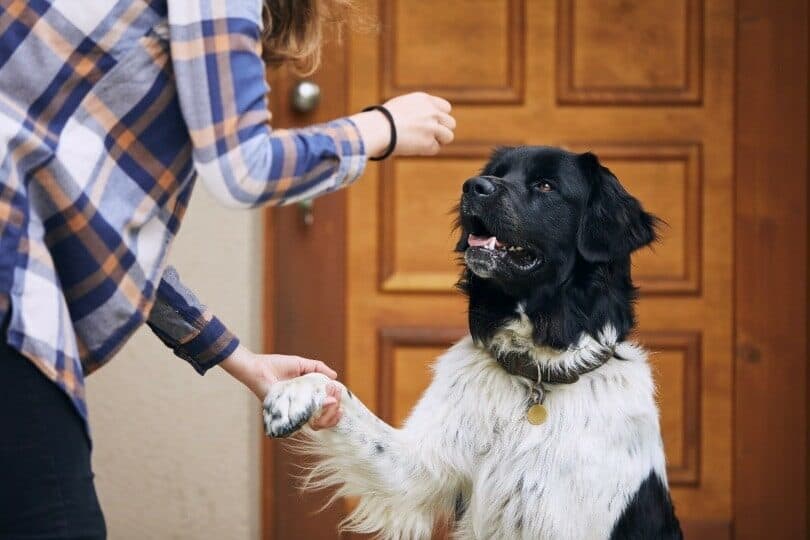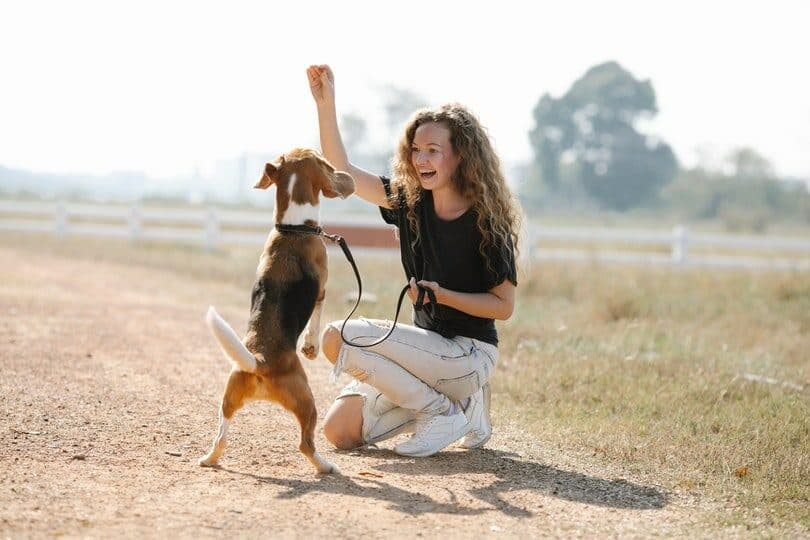Training is an essential part of raising a canine, so every dog parent will eventually have to go through it. It’s much easier to train your dog while it’s still a pup, as it will learn quicker, although there’s no limit to when your canine can learn new tricks.
When it comes to training, one of the first things dog parents should teach their dog is to sit. Although this might sound difficult, the teaching process is straightforward when you know what to do. We want to help all doggy owners through this procedure, so we’ve come up with a step-by-step guide on how to teach a dog to sit.
By following the steps below, your dog will be sitting in no time!
The 9 Simple Steps for Teaching a Dog To Sit
1. Find a Peaceful Practice Spot

Before the training session starts, you should find a peaceful practice spot without any distractions. When training, you need your dog to concentrate on you and your directions, so loud and crowded areas might decrease the training efficiency.
If you cannot find a quiet spot outdoors, you can also do the training inside your home or in your backyard. The only important thing is that you’ll be the center of your puppy’s attention, allowing it to soak in new tricks quicker.
2. Keep the Dog on a Leash
You should do canine training while your dog is on a leash, as you’ll have control, and you can help your dog to keep its attention focused on you. The leash should be tighter than usual, and you could keep a foot on it. Of course, you shouldn’t force your dog to be near you, choke it, or hurt it in any other way.
Keeping your furry friend on a leash while still allowing enough movement will prevent your pup from jumping around and playing, which is beneficial during training. The dog should be concentrated on your movements, facial expressions, and words which is what such a position will allow.
3. Hold a Treat in Your Hand

Treats are another essential thing for successful dog training. Although this might sound strange, treats will be effective in drawing your puppy’s attention to you, and later during the training, they will be an excellent way to praise your dog.
You should put the treat in your hand and place it near your canine’s face or mouth, allowing it to sniff and nibble it. Once you have your dog’s attention, it’s time to go to the next step of the training process.
4. Place the Treat Above Your Dog’s Head
Once your pup is focused, hold the treat between your fingers, and place it between 3 and 6 inches above your dog’s head. Such a placement will encourage your dog in a sitting position naturally as it will allow it to see the treat better.
In case your dog doesn’t raise its head enough, you can move a couple of steps back, making your pup look higher.
5. Say “Sit”

While your canine is moving into the sitting position to see the treat, use the verbal command “sit” and try to emphasize it during pronunciation. You shouldn’t yell at your pet, but you should have a firm, steady tone, showing your pup that this is a command rather than a request.
6. Praise the Dog Once It Sits
Once your furry friend’s bottom touches the floor and makes the sitting gesture, it’s time to praise and reward it. Hand over the treat, pet your best friend, and say encouraging words such as “good dog,” “good sit,” and “well done.”
Ensure that you’re praising the dog when it’s actually seated to allow it to connect the praise with the command. Using treats and praises will help your best friend link good behavior with positive thinking, making further training much easier.
7. Repeat the Process

You should repeat the process while your pup engages and focuses on you and the command. However, you shouldn’t force your dog to practice constantly, so it’s best to repeat the session for about 15 minutes, after which you should take a break.
For the best results, try to train your canine 3 times a day, while each session lasts between 10 and 15 minutes. At the end of each session, continue the praising to allow your pup to realize this is good behavior and to feel more confident and relaxed when sitting.
8. Ditch The Treat
After a couple of training sessions, when your dog is somewhat accustomed to the verbal “sit” cue and your hand gesture when holding the treat, it might be helpful to take the treat away from the training process.
Once your pup sits without the treat, you can get the treat out of your pocket and praise the behavior. The point of this step is for your dog to realize that sitting won’t always mean treats but that the command is beneficial for both of you.
When you’re both more confident, you can also stop holding your pup on a leash and move further back when performing the command. That will add more distractions to your dog, but when it sits, you’ll know that it picked up on the essence of the training. Again, never forget to praise the excellent work, as your pup will appreciate it.
9. Practice Makes Perfect

You shouldn’t worry if your pup takes longer than others to learn the trick, as every dog is unique, and some might take more training sessions than others. If your dog learns slowly, don’t get discouraged. Instead, provide it with the needed attention and love while making this process into a bonding experience.
Practice makes perfect, so you can overcome the sitting challenge together as long as you’re willing to dedicate attention and love to your pup through this development stage.
Things You Should Avoid
Teaching your furry friend to sit can be challenging and time-consuming, so you need an adequate mindset before starting the training. Try to be patient and show enthusiasm towards your canine learning the new trick.
There are things that you should avoid because they could slow down the learning process:
- Don’t force your pup into long training sessions. It’s best for the session to last between 10 and 15 minutes, although you can extend it to 20 minutes if you notice your dog is still focused. However, anything longer than that can have a bad impact on your pup.
- Never get angry or punish your dog if it doesn’t learn the command instantly. Some puppies will need longer than others to soak in all the new information, and there’s nothing wrong with that. Instead, practice your patience, and encourage your dog along the way, regardless of how long it takes.
- Always connect the “sit” verbiage with positivity and good thoughts. That will allow your canine to relax and feel secure and loved while performing the command.
Final Thoughts
Teaching your dog a new trick is a remarkable experience for both you and your canine. If you approach the training session with a positive mindset and patience, it will help you bond with your furry friend and develop a much stronger connection. Showing enthusiasm will make your dog want to engage, and it will learn the trick with ease.
Featured Image Credit: Svetlbel, Pixabay
















